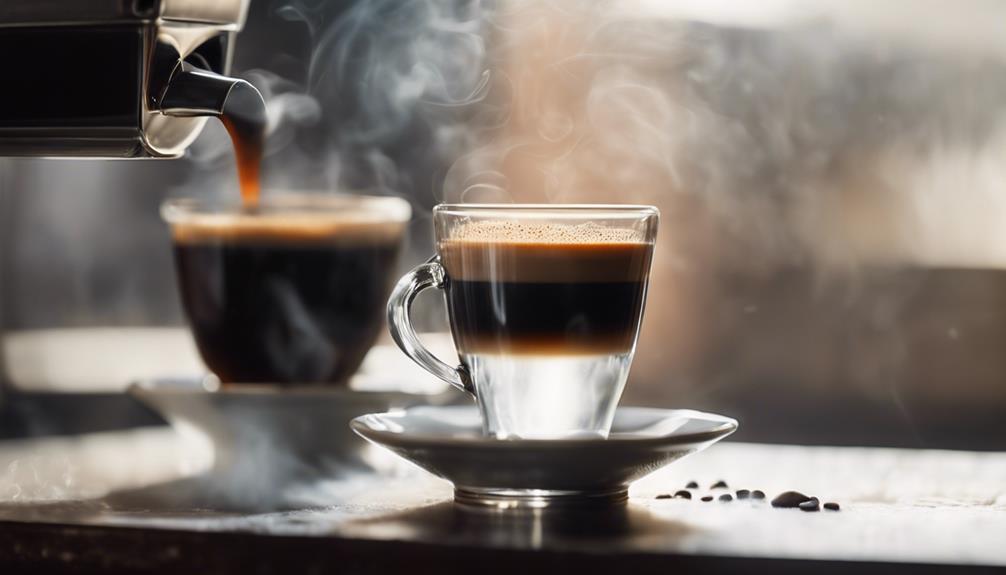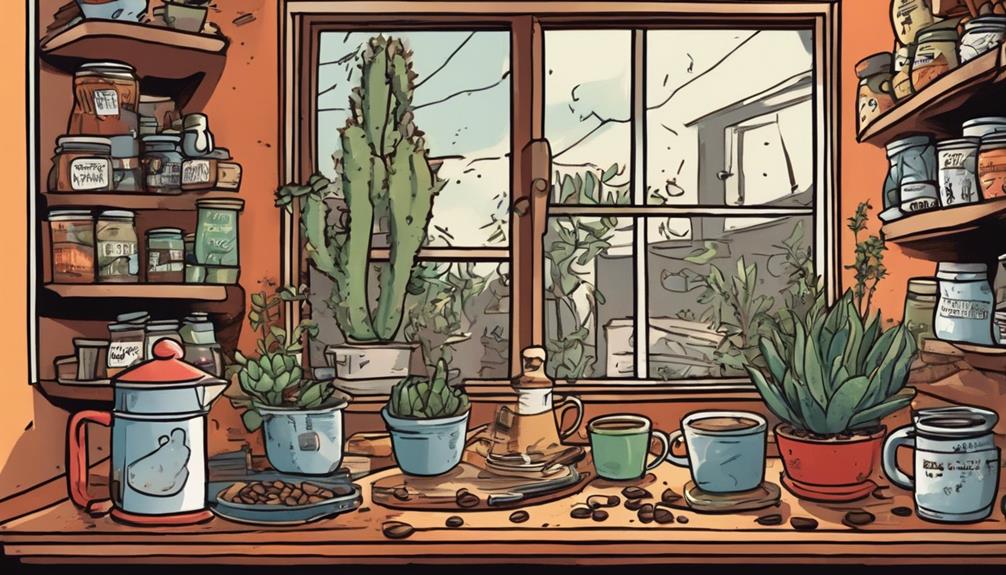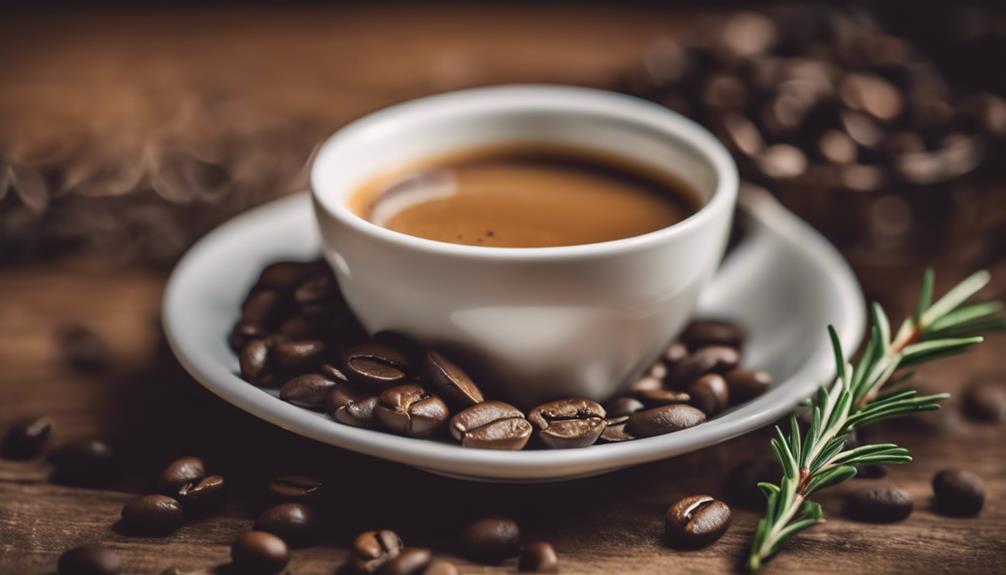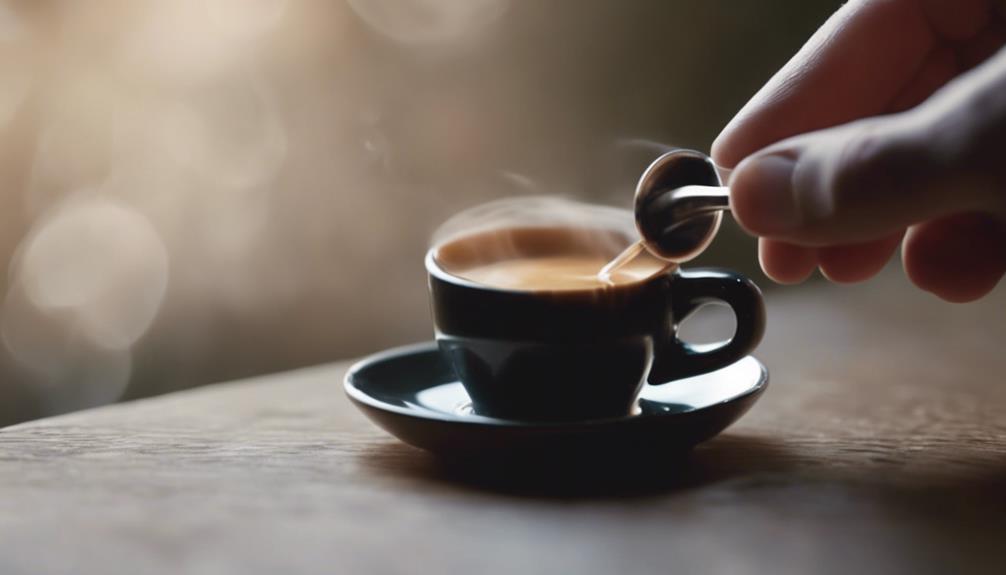When choosing between **espresso** and **coffee**, you might assume a shot of espresso has more caffeine than a full cup of coffee, but that’s not always true. While espresso has a higher concentration of caffeine, about 63 milligrams per ounce, brewed coffee can have more overall, ranging from 95-200 milligrams per 8 ounces. Factors like brewing methods, bean type, and roast level also affect **caffeine levels**, making it challenging to make a general statement. As you explore further, you’ll uncover the differences that set these two popular drinks apart – finding out what truly gives you that **morning boost**. So, do you know which one will kick-start your day?
Key Takeaways
- Espresso has a higher caffeine concentration (63 mg/oz) compared to brewed coffee (12-16 mg/oz) due to its high-pressure brewing method.
- Despite this, brewed coffee often contains more total caffeine due to its larger serving size (8 oz vs 1 oz).
- To match the caffeine content of 8 oz brewed coffee, approximately 1.5 shots of espresso are needed.
- The brewing method and bean type affect caffeine levels, with espresso's rapid extraction and Robusta beans contributing to its higher caffeine content.
Caffeine Content Showdown
When you're reaching for a caffeine boost, you might wonder which packs a bigger punch: a shot of espresso or a cup of brewed coffee. Let's explore the caffeine content in coffee to find out.
A single espresso shot (1 ounce) contains approximately 63 mg of caffeine, while an average cup of drip coffee (8 ounces) contains about 95-200 mg of caffeine. So, a typical cup of brewed coffee has more caffeine than a shot of espresso.
However, espresso has a higher caffeine concentration, averaging about 63 mg per ounce, compared to brewed coffee's 12-16 mg per ounce. If you're looking to match the caffeine content of an 8-ounce brewed coffee, you'd need around 1.5 shots of espresso.
Despite having less total caffeine, the rapid consumption of espresso can lead to a quicker increase in caffeine levels in the bloodstream compared to slower-sipped brewed coffee.
Now you know the difference in caffeine content between espresso and brewed coffee, making it easier to choose your next caffeine fix.
Brewing Methods Matter
By examining the brewing methods behind espresso and coffee, you'll discover that the way you brew your coffee can greatly impact the final product, particularly when it comes to caffeine content and flavor profile.
The brewing methods of espresso and drip coffee are vastly different, which affects the caffeine extraction and flavor release. Espresso is brewed by forcing hot water through finely-ground coffee under high pressure, resulting in a rapid caffeine extraction within the first minute.
This process yields a higher concentration of caffeine per ounce compared to drip coffee, which involves pouring hot water over coarser grounds and takes 3-6 minutes to brew.
The grind size also plays a significant role, with espresso requiring a very fine grind for maximum extraction efficiency and drip coffee needing a medium grind for slower infusion of flavor.
These differences in brewing methods not only affect caffeine levels but also influence flavor profiles, with espresso delivering a concentrated taste and drip coffee offering a milder, more diluted flavor experience.
Bean Type and Roast Level
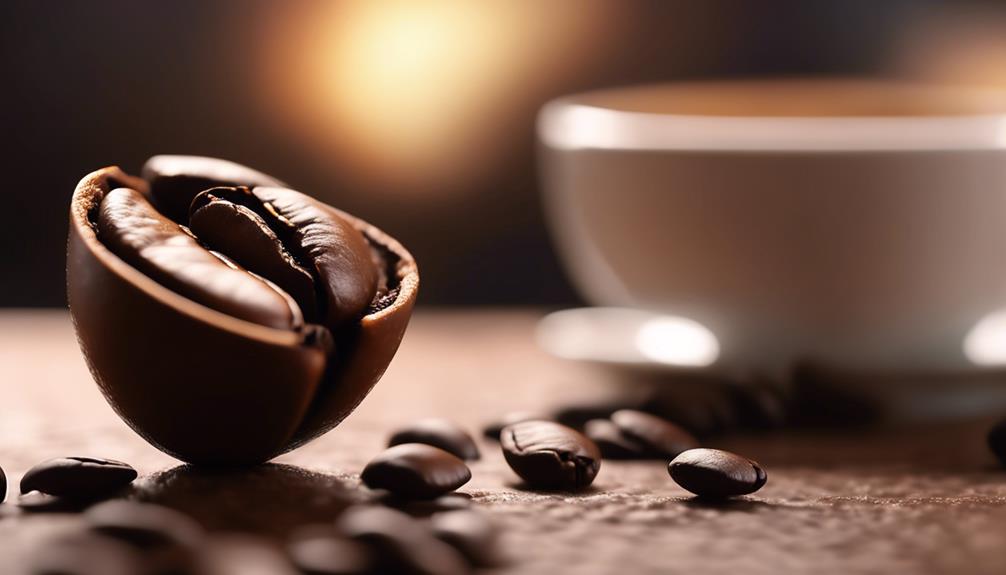
You'll find that the type of coffee bean and roast level you choose also play considerable roles in shaping the flavor and caffeine content of your espresso or coffee. The choice between Arabica and Robusta beans, for instance, can considerably impact the caffeine concentration in your brew. Arabica beans, commonly used for drip coffee, have a lower caffeine content compared to Robusta beans, which are often included in espresso blends for added strength and flavor.
| Bean Type | Roast Level | Caffeine Concentration |
|---|---|---|
| Arabica | Light | Higher |
| Arabica | Dark | Lower |
| Robusta | Dark | Higher |
As you can see from the table, the roast level also affects the caffeine concentration, with lighter roasts retaining slightly more caffeine than darker roasts. Understanding these differences can help you choose the right coffee or espresso based on your flavor preferences and desired caffeine content. By selecting the right bean type and roast level, you can optimize your brewing experience and enjoy a cup that suits your taste buds.
Grind Size Impacts Caffeine
The grind size of your coffee beans plays a significant role in determining the caffeine content of your espresso or coffee, as it directly affects the rate of extraction during brewing.
When you're brewing espresso, a very fine grind size is essential, resembling the texture of fine sand. This increases the surface area, enhancing caffeine extraction.
On the other hand, drip coffee uses a medium grind size, allowing for a slower infusion of flavor and caffeine extraction over a longer brewing time.
Here are three key points to keep in mind:
- Finer grind size for espresso: Leads to quicker extraction, with most caffeine being released within the first minute of brewing.
- Coarser grind size for drip coffee: Results in a slower extraction, with caffeine being released over a longer period.
- Grind size adjustment is vital: Balances caffeine strength and flavor profile, as espresso's higher caffeine concentration per ounce results from its preparation method and grind size.
Extraction Time and Pressure
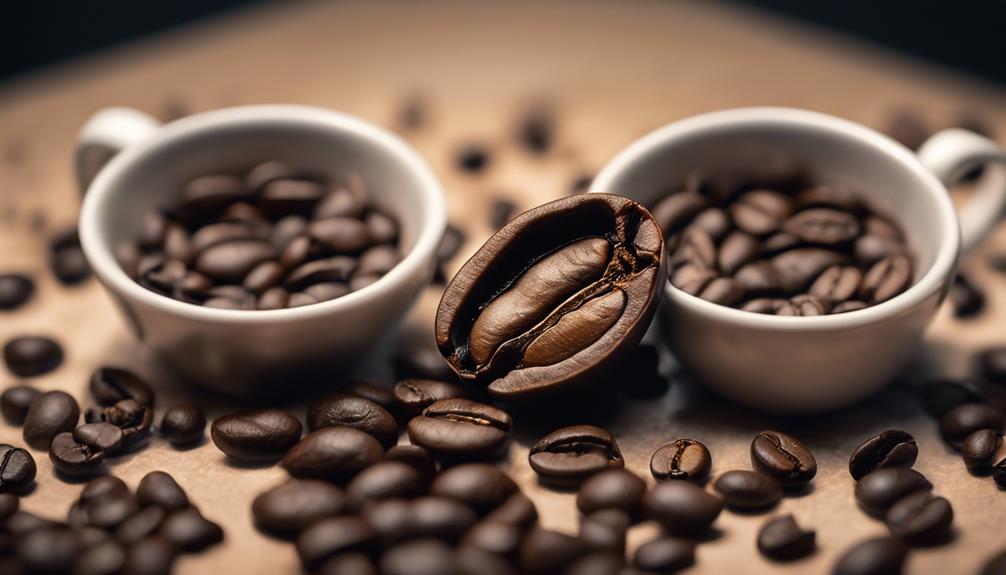
As you brew your coffee, the time it takes to extract the flavors and caffeine plays a considerable role in shaping the final product. Espresso's high-pressure, rapid extraction process sets it apart from other brewing methods.
When you force hot water through finely ground coffee at around 9 bars of pressure, you get a concentrated flavor and crema. This process is remarkably quick, taking only 20 to 30 seconds to extract the caffeine and flavors from the coffee grounds.
In contrast, drip coffee brewing takes considerably longer, usually between 3 to 6 minutes, leading to a different extraction profile and flavor development.
The efficiency of caffeine extraction in espresso is maximized during the first minute of brewing, with most caffeine being released during the initial 20-30 seconds. This rapid extraction time, combined with the finely ground coffee, enables a higher caffeine concentration compared to coarser grind methods.
The high pressure and short extraction time in espresso brewing create a unique environment that allows for peak caffeine extraction, making it a standout among brewing methods.
Espresso's Unique Characteristics
As you explore the world of espresso, you'll notice it has some standout traits that set it apart from regular coffee.
You're about to discover how espresso's concentrated caffeine content, rapid absorption rate, and effect on your central nervous system work together to create a unique coffee experience.
These characteristics will give you a deeper understanding of why espresso is a favorite among coffee enthusiasts.
Espresso's Concentrated Caffeine Content
You'll get a bigger caffeine kick from a single ounce of espresso than from a full cup of brewed coffee. This is because espresso is incredibly concentrated, with approximately 63 mg of caffeine per 1-ounce shot. In contrast, regular coffee averages 12-16 mg of caffeine per ounce.
Here are some key facts to keep in mind:
- Espresso's high caffeine concentration: 63 mg per 1-ounce shot, making it notably more concentrated than regular coffee.
- Brewing process: The high-pressure brewing process for espresso extracts caffeine quickly and efficiently, contributing to its concentrated nature.
- Comparison to brewed coffee: While a double shot of espresso (2 ounces) delivers around 126 mg of caffeine, an 8-ounce cup of brewed coffee usually contains about 95-200 mg of caffeine, depending on the brewing method.
Despite its higher concentration, the total caffeine content in a standard serving of brewed coffee is often greater due to its larger volume.
However, the concentrated caffeine content in espresso is a key factor in its unique characteristics and the reason why it packs such a potent punch.
Espresso's Rapid Absorption Rate
One key characteristic that sets espresso apart is its rapid absorption rate, which allows the caffeine to kick in faster and more intensely than brewed coffee.
When you take a shot of espresso, the concentrated caffeine is quickly absorbed into your bloodstream, producing a more immediate stimulant effect. This is due to the fact that espresso is consumed quickly, typically in a matter of minutes, allowing the caffeine to hit your system rapidly.
In contrast, brewed coffee is often sipped over a longer period, slowing down the absorption rate of its caffeine. As a result, you may feel a more pronounced energy boost from a shot of espresso compared to a cup of brewed coffee.
Additionally, your individual caffeine tolerance and sensitivity can influence how you experience the effects of espresso, making the rapid absorption rate even more noticeable.
Espresso's Central Nervous System Effect
With its high caffeine concentration and rapid absorption rate, espresso has a profound effect on your central nervous system, influencing alertness, mood, and energy levels. The intense caffeine kick from a single shot of espresso can make a significant difference in how you feel, and this is due to its unique brewing method. Unlike brewed coffee, espresso's high-pressure brewing process maximizes caffeine extraction, resulting in a more potent beverage.
Here are three key ways espresso affects your central nervous system:
- Caffeine absorption: Espresso's rapid consumption and high caffeine concentration lead to quicker absorption, causing a more pronounced energy boost.
- Individual tolerance: Your individual tolerance to caffeine can affect how espresso influences your alertness and mood, making the experience unique to you.
- Gentler on the stomach: Espresso's lower acidity, due to its shorter brewing time, can make it a more comfortable choice for those who experience discomfort from regular coffee.
Coffee's Gradual Awakening
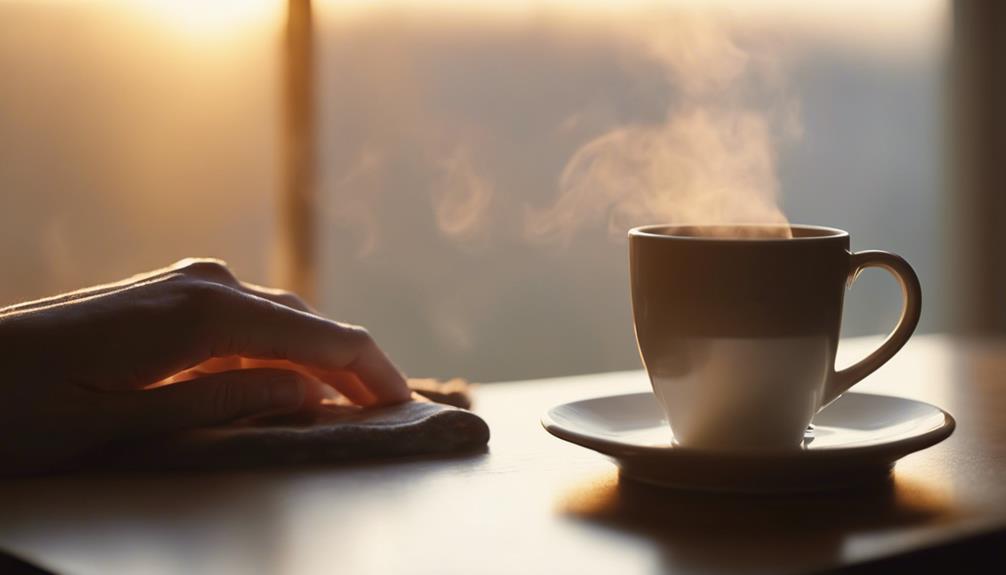
As you start your day with a cup of coffee, you're likely looking for a morning boost to get you going.
You'll notice that coffee's gradual awakening is due in part to its slower caffeine absorption rate, which helps you feel more alert and focused throughout the morning.
Now, let's explore how these factors work together to give you the energy lift you need to tackle your day.
Morning Boost
You start your day with a warm cup of coffee, which gradually awakens your senses with a steady flow of caffeine that lasts throughout the morning. This morning boost is due to coffee's unique characteristics, which set it apart from espresso.
Here are three key reasons why coffee provides a more sustained energy boost:
- Larger serving size: Coffee is typically consumed in 8-ounce cups, providing a gradual intake of 95-200 mg of caffeine that lasts throughout the morning.
- Slower release of caffeine: The brewing method for coffee takes 3-6 minutes, resulting in a slower release of caffeine compared to espresso.
- Lower caffeine concentration: Coffee's lower caffeine concentration per ounce, averaging 12-16 mg, means it's sipped slowly, leading to a more prolonged caffeine effect.
Unlike espresso, which provides an immediate jolt, coffee's gradual awakening experience makes it preferable for those seeking a calmer start to their day.
As you sip your coffee, the caffeine is absorbed over a longer period, providing a sustained energy boost that helps you tackle your morning routine with ease.
Caffeine Absorption Rate
The difference in caffeine absorption rate between espresso and coffee lies in their consumption styles, which greatly impact how you experience their energizing effects.
When you down a shot of espresso, you're consuming a concentrated dose of caffeine quickly, leading to a rapid absorption into your bloodstream. This rapid ingestion can enhance the initial jolt you feel from the caffeine.
On the other hand, when you sip on a regular cup of coffee, whether it's a cup of drip coffee or another brewing method, you're consuming a larger volume of liquid over a longer period. This slower consumption leads to a more gradual caffeine absorption rate, resulting in a prolonged awakening effect.
The caffeine content in a standard 8-ounce cup of coffee averages around 95 mg, whereas a 1-ounce shot of espresso contains approximately 63 mg.
This difference in total volume consumed also plays a role in how you experience the caffeine. Your individual tolerance levels and psychological factors can further influence how you perceive the effects of caffeine, but the consumption style of each beverage sets the stage for how you'll feel the energizing effects.
Caffeine Sensitivity and Limits
Caffeine sensitivity varies greatly from person to person, making it essential to understand your individual limits to avoid adverse effects. You might be surprised to learn that your body's response to caffeine can differ considerably from someone else's. This is because individual caffeine sensitivity can vary widely, with some people experiencing heightened effects from small amounts, while others may require more to feel the same stimulation.
To better understand your limits, consider the following:
- Daily caffeine limit: The FDA recommends a safe daily limit of 400 mg, equivalent to about four 8-ounce cups of brewed coffee or 7-8 shots of espresso.
- Rapid consumption: Be cautious when consuming espresso, as its concentrated nature can lead to a quicker and more intense caffeine jolt.
- Individual tolerance: If you're a regular consumer of caffeine, you may develop a tolerance, impacting your sensitivity and the effects experienced from both espresso and coffee over time.
Acidity and Stomach Sensitivity
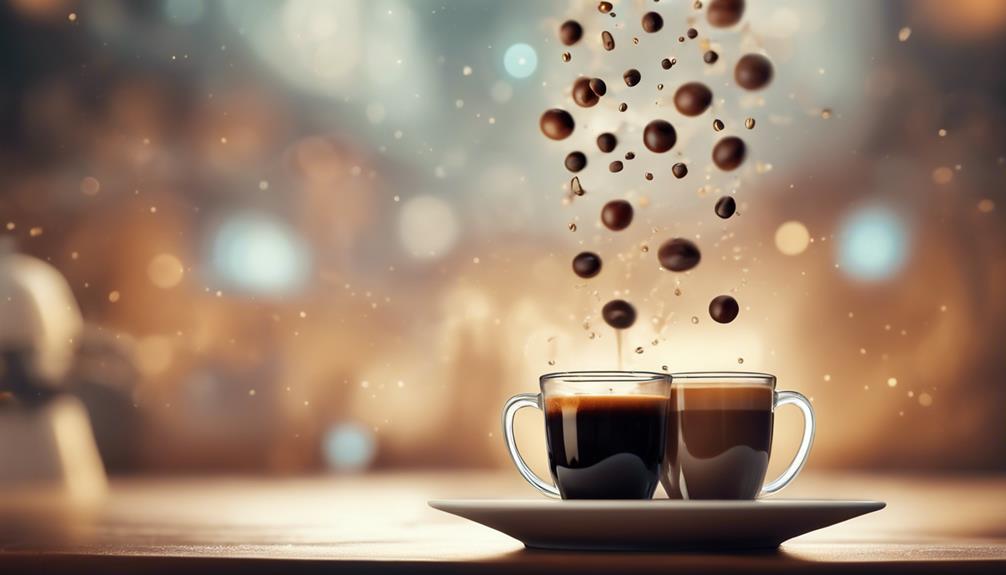
How does your stomach react to the acidity levels in your morning coffee or espresso shot? If you're someone who experiences stomach sensitivity, you might want to take into account the acidity levels in your daily brew.
Espresso generally has lower acidity compared to regular coffee, making it a smoother choice for sensitive stomachs. This is due to the shorter brewing time, which results in a less acidic taste. On the other hand, brewed coffee can be harsher on the stomach, especially for those who are prone to discomfort.
If you're looking for a gentler option, think about low-acidity coffee beans, such as those from Brazil. Darker roasts of regular coffee can also help mitigate acidity levels, making them a better choice for those who experience stomach upset.
Additionally, decaffeinated options are available for both espresso and coffee, providing a solution for those with caffeine sensitivity while still taking into account acidity levels.
Debunking Caffeine Myths
What's driving your caffeine choices – fact or fiction? You might be surprised to learn that many common beliefs about caffeine are actually myths. Let's separate fact from fiction:
Here are three common myths debunked:
- Espresso has more caffeine than coffee: Not necessarily. While espresso has a higher caffeine concentration per ounce, a typical 8-ounce cup of brewed coffee usually contains more caffeine overall.
- Dark roast coffee has more caffeine than light roast: The roasting process has a minimal impact on caffeine content. In fact, lighter roasts might have slightly higher levels due to reduced volume loss during roasting.
- Caffeine affects everyone equally: Not true. Your individual tolerance and sensitivity to caffeine depend on factors like genetics, habitual consumption, and overall health.
Don't let myths guide your caffeine choices. Understand the facts, and you'll be better equipped to make informed decisions about your espresso and coffee habits.
Whether you prefer a strong shot of espresso or a cup of brewed coffee, knowing the truth about caffeine will help you make the most of your daily dose.
Frequently Asked Questions
Is Espresso Stronger in Caffeine Than Coffee?
You wonder if espresso is stronger in caffeine than coffee, and the answer is yes, per ounce, but surprisingly, a typical 8-ounce cup of brewed coffee contains more total caffeine than a single shot of espresso.
How Many Espresso Shots Equal a Cup of Coffee Caffeine?
You're wondering how many espresso shots equal a cup of coffee's caffeine content. To match the 95 mg in a standard cup, you'll need about 1.5 shots of espresso, which will give you roughly the same caffeine kick.
Is Espresso Healthier Than Coffee?
You wonder if espresso is healthier than coffee; the answer depends on your sensitivity to acidity and caffeine intake. Since espresso has lower acidity and controlled caffeine amounts, it might be a better option for you.
How Does Espresso Differ From Coffee?
You're about to uncover the ultimate showdown: espresso vs coffee! These two coffee titans differ drastically in brewing methods, grind sizes, and even flavor profiles, with espresso packing a concentrated punch in a tiny cup.
Conclusion
As you navigate the complex world of caffeine in espresso vs coffee, remember that each cup is a nuanced puzzle. It’s important to consider not just the flavor and caffeine content, but also the potential health risks of espresso due to its higher concentration of caffeine. While some studies have suggested that moderate coffee consumption may have health benefits, consuming too much caffeine, whether from espresso or coffee, can lead to negative effects such as anxiety, insomnia, and irregular heartbeats. It’s always best to enjoy your daily cup of caffeine in moderation and be mindful of your own body’s response to it.
The brewing method, bean type, roast level, grind size, and extraction time all piece together to create a unique caffeine experience.
So, don't be a pawn in the caffeine game – be the master of your morning cup, and brew your way to a perfect blend that awakens your senses like a conductor leading a symphony.
